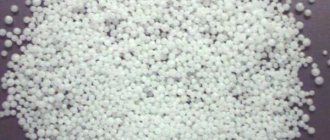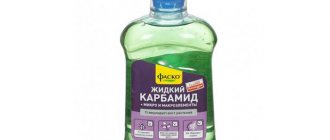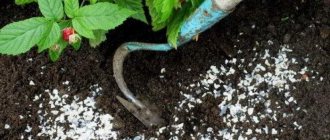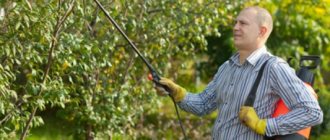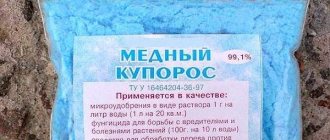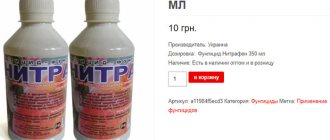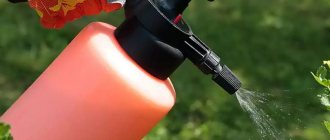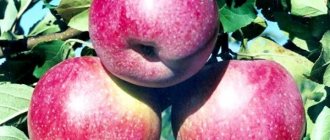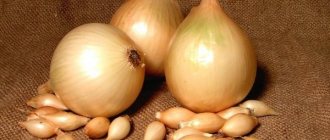What is apple scab: signs and stages of the disease
Apple scab
A fungal infection (in Latin Venturia inaequalis) affects young foliage and affects fruiting. The disease spreads slowly and imperceptibly, so it is not immediately noticed by the owner of the apple orchard. Primary signs are recorded upon completion of flowering: yellowish-greenish spots form on the foliage, some have a grayish coating. Gradually they turn black, capture most of the leaf blade and migrate to the fruit.
Severe damage appears on summer days at the ovary stage. It does not allow the apples to ripen: they become deformed and look like wrinkled lumps. The appearance of pathology during ripening changes the appearance of apple fruits, becoming covered with spots and cracks. The product is suitable for recycling only.
Important! The quickly yellowing foliage falls off, becomes a wintering site for the fungus, and in the spring it again moves onto the tree and scatters throughout the garden.
Disease development cycle
Treatment with copper-containing liquids and agronomic chemistry
If you don’t trust natural preparations and traditional “whitewashing,” you can turn to other means. One of the best ways to treat an apple tree for scab in the fall after harvesting is copper sulfate.
It is applied to the branches and trunk of trees after the standard stripping of damaged bark has been carried out. For this, a 5% substance is used, which is diluted according to the instructions.
If the tree is severely affected, you need to decide what to spray the apple trees against scab in the fall. The first treatment in this way is carried out immediately after the flowers fall. For this you need to use the following drugs:
- “Bordeaux mixture”, consisting of copper sulfate and calcium hydroxide, which is an aqueous solution), and is used to destroy fungal diseases and pests;
- “Tsineb” is a fungicide that prevents the development of diseases on fruit trees;
- "Kaptan" is a fungicide that has a similar effect as other drugs in its group;
- "Kuprozan" is a moderately toxic agent that protects the tree from any diseases.
In order to prevent the spread of scab on branches and fruits, it is enough to carry out two treatments. However, if the disease has managed to grow, it is necessary to alternately spray the tree with 2-3 preparations according to the instructions at least 4-6 times.
This must be done from early spring until late autumn. It is important to become familiar with the specifics of treating trees with these drugs and take precautions.
Why does scab appear on apple trees?
Scab on a pear - a description of the disease and how to deal with it
The description states that the pathology occurs:
- with frequent planting of fruit trees and plantings of one variety;
- neglect of a personal plot - in the absence of autumn cleaning of fallen leaves;
- failure to comply with sanitary pruning standards.
Scab on apple tree leaves develops in warm and humid weather. The optimal environment for the fungus is considered to be a temperature of 18-20 degrees with rain and fog.
Features of processing tree trunks
To prevent the appearance of fungus or get rid of it, you need to choose how to treat apple trees in the fall against scabs and
. It is necessary to begin after the completion of harvesting work.
May be interesting Mustard and vinegar against the Colorado potato beetle: recipes, methods of application Mealybugs on indoor plants How to get rid of shrews in the garden?
When there is not a single fungus-affected apple left on the tree, do the following:
- We remove all dried, unopened shoots.
- We use a garden knife to clean the affected areas of young branches until they reach healthy wood.
- We do the same with the trunk, confidently cutting off all the swollen and “scaly” parts of the bark.
- We clean everything with a chisel so that it turns out smooth and neat.
Preparing a solution for whitening apple trees. Mix 1 cup of slaked lime, ½ part of a bucket of clay and manure, making the composition the consistency of sour cream. If you couldn’t find the first component, replace it with 1 cup of wood ash. We add the preparations “Fitosporin-M” and “Fitoverm”, which kill parasitic fungi and protect the tree from new lesions.
The composition itself will help the bark recover and rejuvenate. This is one of the first stages of treating apple trees in the fall against scab and pests in order to prevent further infection.
All cut parts of the tree and fallen leaves can be burned to prevent the spread of the fungus in the spring. This procedure can be carried out annually to prevent scab, other diseases and insect pests.
Preventive measures to protect the garden from scab
Leaf roller on an apple tree - how to fight and what to treat
Preventing the development of pathology includes several rules: from cleaning the area to properly planting seedlings.
Autumn litter cleaning
With the onset of the autumn months, the owner needs to get rid of fallen leaves, broken and dried branches, and rotten apples. They are sent to a compost pit for 2-3 years or removed from the site.
Cleaning up fallen leaves
Whitewashing apple trees
Before whitening, it is necessary to remove the exfoliated bark. After cleaning, the bare areas are coated with copper sulfate (1 tablespoon of the substance per 1 liter of water), and in late autumn the trunk and skeletal branches are whitewashed.
Be careful when applying fertilizers
The fertilizer application schedule is prescribed by the manufacturer. In acidic soils, apply a double portion of nitrogen fertilizer - its high content prevents the development of the disease.
Preventative treatment
Before the buds open, the tree and the ground around it must be treated with a 1% solution of Bordeaux mixture. In its absence, biological products with a similar effect can be used.
Important! Increasing immunity and additional protection of the crop is carried out with “Epin”, “Ecoberin”, “Zircon”, “Healthy Garden”, etc.
Optimal distance of trees from each other
When landing, use the following scheme:
- tall and medium apple trees - every 4 m;
- low-growing - after 3 m.
Important! Rare planting prevents increased humidity of the crown, reducing the risk of developing pathology.
Distance between apple trees
Apple tree varieties resistant to scab
Constant scab on apples requires planting of certain varieties. Species resistant to pathology are presented:
- Vasilisa;
- Asterisk;
- Margo;
- Lungwort;
- Orlinka;
- Delight;
- Juno.
Important! For beginners in gardening, experts advise starting with planting Zvezdochka and Lungwort.
Disease prevention
Significant damage to the apple crop, both quantitatively and qualitatively, is caused by various pests and diseases (infectious and physiological). In order to preserve, if possible, all the ovaries, and then the fruits, it is important to systematically carry out protective measures.
To be effective, they are performed within the recommended time frame, which, as a rule, corresponds to phenological phases. Processing Tips:
- If trees are severely damaged by scab and moniliosis (fruit rot), in previous periods, approximately once every 3-4 years, you can apply “blue spraying” - treatment with 3% Bordeaux mixture.
- During this period, you can spray the trees with a 5% solution of iron sulfate or Farmayod solution against lichens.
- During the green cone phase - the period when leaves begin to bloom - it is worth checking apple trees for the presence of apple moth and hawthorn caterpillars. If they are present, it is recommended to carry out insecticidal treatment, that is, spray with a preparation that kills insects.
Advice!
It is advisable to choose a drug taking into account the air temperature.
So, in relatively warm weather, that is, at a temperature of 16 degrees or more, it is recommended to use a biological preparation, for example, Lepidocide or Fitoverm. In this case, the harvest can be considered environmentally friendly.
Currently, garden plants are increasingly being attacked by pests and various diseases. Therefore, you need to be prepared to take certain measures. If during this period the weather is cool, then if the number of caterpillars is high, it is sometimes permissible to use a chemical preparation, for example, Alatar, Fufanon, Iskra.
Step-by-step instructions for spring scab control measures
There are many methods for treating pathology; gardeners can choose the most suitable option. Fungicides, traditional methods and concentrated fertilizers are used against the fungus.
How to treat scab with fertilizers
Powdery mildew on an apple tree - how to fight and treatments
In therapy it is used:
- 10% ammonium nitrate;
- 5% potassium chloride;
- 10% ammonium sulfate;
- 5% potassium sulfate;
- 7% potassium salt;
- 7% potassium nitrate.
Important! The technique is controversial: huge doses of mineral fertilizers have a negative effect on the soil and its inhabitants. It is not worth using such treatment methods often.
Chemicals for scab control
How to treat scab on an apple tree: fungicidal solutions (Hom, etc.). To reduce the risk of pathogen addiction, medications need to be alternated.
Copper and iron sulfate
The destruction of scab spores is carried out:
- in spring - 2-5 liters of copper sulfate (at an air temperature of 5-10 degrees);
- in autumn - 5% iron sulfate (after the leaves fall).
Important! Bare branches are treated with substances; their contact with the green part can cause burns.
Copper sulfate
Bordeaux mixture
The concentration of the solution depends on time:
- before bud break - 3%;
- during the formation of buds - 1%.
Important! The procedure with a 1% solution is carried out at intervals of two weeks, until the apples appear.
"Horus"
The effect of the active substance cyprodinil lasts up to 28 days. Therapy is carried out twice: when the buds are in the “green cone” stage and 10 days after flowering.
"Strobe"
The active effect of the substance lasts 35 days, therapy is carried out three times, with an interval of 2 weeks. The drug can be combined with other fungicides.
"Skor" (analogues - "Keeper" and "Rayok")
During the season there are two procedures, before and after budding, with an interval of 2 weeks. One tree needs up to 5 liters of solution, each ampoule is diluted with 10 liters of liquid. The speed is valid for no more than 20 days.
Drug "Skor"
Biological products against scab
Biological substances are considered less toxic and more effective than homemade infusions.
"Baktofit"
The concentrated medication allows you to fight the massive spread of fungal infection. Procedures are carried out every 8 days, 4-7 times a season. The effect lasts from 7 to 20 days.
"Fitolavin"
Refers to antibiotics with a systemic and contact spectrum of action; each culture requires 5 liters of solution (20 ml per 10 liters of liquid). When processing, a period of 15 days is maintained; throughout the season, you need to spray the garden 4 times.
Fungicide "Fitolavin"
"Fitosporin-M" and "Zircon"
A mixture of 1 ml of “Zircon” and 5 g of “Fitosporin-M”, diluted in 10 liters of water, is used to fight fungus and increase the level of immunity. The drugs are safe and can be used throughout the season. The procedures take place at intervals of 14 days.
Important! For better interaction with foliage, add a little liquid soap to the solution.
"Gamair"
Therapy is carried out three times during the growing season:
- during the formation of buds;
- after flowering;
- when apples develop to the size of a hazelnut.
Up to 5 liters of solution is consumed for each crop; it is prepared from a bucket of water and 10 tablets of medicine.
"Agat-25K"
The product is used three times during the growing season; 1.2 g of substance is needed per 6 liters of liquid. Each plant will need 2-6 liters of solution - as the tree grows.
"Agat-25K"
How to defeat apple scab with folk remedies
Home remedies help at the initial stage of the spread of infection; if the infection spreads massively, they are pointless.
- Salt. The saline solution is prepared from 1 liter of liquid and 100 g of table salt. After complete dissolution, the infected areas are treated with the mixture.
- Mustard. 8 g of mustard powder is dissolved in a liter of water. The mixture is used for spraying; four applications are allowed during the entire growing season.
- Potassium permanganate. A bright purple solution of potassium permanganate will help fight scab. The prepared medication is sprayed throughout the apple tree.
- Horsetail infusion. Finely chopped greens are poured with water (1 to 3), tightly closed and left for three days. After filtering the finished substance, you need to spray the green part and the trunk.
Horsetail infusion
Instructions for use
Urea can be used in several ways:
- spraying against pests;
- foliar feeding in summer;
- root feeding.
Many gardeners make the mistake of simply spreading the granules onto the snow or soil when it rains, thinking that the melted snow and rain will carry the urea into the soil. Unfortunately, precipitation only washes out the substance and transfers it not to the roots, but throughout the area. In addition, in sunlight and under the influence of water, the granules quickly decompose, and useful nitrogen does not reach the roots.
Spraying is carried out in dry, cloudy, windless weather, if possible in the early morning or late afternoon. Root feeding is applied by digging up the tree trunk in cloudy weather to avoid rapid decomposition of urea under the influence of sunlight.
Root application
Root feeding can be done in two ways - add granules during the spring digging of the tree trunk or water the tree with a working solution.
When adding solid granules, the soil around the tree trunk is slightly moistened with water, then dry granules are scattered in a thin layer over the surface of the soil and allowed to swell for some time. Then the soil is dug shallowly, the surface is loosened and watered again with a small amount of water. This application is carried out in cloudy weather to avoid rapid decomposition of urea.
Watering with urea can be carried out up to three times per season - in spring, in summer during active fruiting and in early autumn after harvesting. Before watering, the soil around the tree trunk is loosened shallowly, then watered at the rate of 10 liters of working solution per tree. The solution is evenly distributed throughout the entire circle around the trunk, avoiding a distance of 10–15 cm directly from the trunk itself.
When fertilizing for several days before and after, the use of superphosphates, chalk and lime is prohibited!
Pest treatment
Treatment against pests is carried out in early spring before the buds awaken.
Spraying requires little preparation of the tree. The trunks should be whitened, and sanitary pruning of old, dry and diseased branches that did not survive the winter well should be carried out. Before spraying, remove loose bark from the branches and trunk, cover frost holes and cracks with garden varnish. To do this, prepare a working solution according to the instructions and treat the branches, buds and trunk. For spraying, it is better to use a backpack sprayer with an extended tube, especially for tall trees. The treatment is carried out from under the crown, wetting each branch and bud, as well as the trunk. Apply the solution with caution to cracks and frost holes if they have not been treated with garden varnish.
Foliar feeding
Foliar feeding is applied mainly in the summer, when the tree shows signs of nitrogen starvation.
It is less effective compared to the root one, but nitrogenous substances reach the foliage and ovary faster. This type of feeding is similar to treatment against diseases and harmful insects, but the working concentration is somewhat different. Foliar feeding is carried out at the beginning of summer when the ovary is forming. The working solution is poured into a sprayer and the crown is treated from below, carefully ensuring that the liquid gets onto the entire ovary and foliage. Spraying is carried out in dry, cloudy, windless weather in the early morning or evening close to sunset.
Scheme for treating apple trees for scab
The gardener must remember that pathogenic microorganisms quickly adapt to any medicine, so several drugs must be used for therapy. You can alternate biological and chemical substances, in between carrying out procedures with mineral fertilizers.
Comprehensive treatment includes:
- Primary autumn treatment - after leaf fall, at positive air temperatures (up to 4 degrees). The garden and area are sprayed with a concentrated urea solution. This approach will reduce the number of fungal spores.
- Secondary - carried out before the buds open, using a 3% solution of Bordeaux mixture or copper sulfate. The peri-stem circle is treated with the same substance - this will get rid of the surviving fungal spores.
The control procedure is prescribed for the period of completion of flowering. The use of one of the systemic medications will help stop pathogens that have penetrated the foliage - “Skora” or any other.
Spraying an apple tree
Processing times
The processing time depends largely on the purpose of using urea.
- In spring, the optimal use of urea is to spray plants to protect them from harmful insects that have overwintered in the bark and soil, as well as from the proliferation of pathogens of various infections. In addition, spraying treatment stimulates the awakening of buds and leaf formation.
The timing of processing in spring varies in different regions depending on the climate. It is necessary to take into account the temperature - the treatment is carried out after the average daily temperature has been established at +5 degrees for several days. It is important to carry out the treatment before the kidneys awaken.
- In summer, root feeding is carried out along the roots to form larger fruits and accelerate their ripening.
- Preventive treatment is also carried out in the fall during the first stage of leaf fall, especially if signs of disease appear on the foliage: spotting, rust, scab. Autumn root feeding increases the resistance of plants to cold weather. The optimal time for applying urea in the fall is early November; in cold autumn, the timing may shift to the third decade of October.
Why treat in the fall?
The easiest way to identify scab on a tree is during the ripening period of apples. The fruits are small, with black spots, and crumble. Autumn is the right time to treat apple trees against fungus. At this time, the harvest is harvested and the leaves begin to fly off. It is effective to treat apple trees in the fall against scab with special preparations, so that by spring the plantings have recovered from infection and are healthy.
Characteristics of the disease, description of scab symptoms
Scab is a fungal disease caused by the marsupial microorganism Venturia inaequalis. The course of the disease is accompanied by damage to the leaves, their petioles, inflorescences, stalks and the fruits themselves. Scab cannot cause the death of a tree, but it significantly harms the future harvest: it impairs the taste and appearance of the fruit, and shortens the duration of their storage. In central Russia, losses from scab amount to approximately 40% of the crop, and in years with unfavorable climatic conditions - up to 80%.
The fungus overwinters in damaged tree bark and fallen leaves, and in the spring, during the period of bud formation, it begins to disperse spores throughout the orchard. The spread of spores is facilitated by rain, wind and insects flying from tree to tree.
Favorable conditions for the activation of the fungus Venturia inaequalis are created on rainy days with air temperatures from +18 to +20 ° C and humidity up to 80%.
Scab is common in areas characterized by rainy summers. In regions with hot and dry climates, this disease is much less common.
Signs of defeat
Once on young foliage, the spores germinate.
In early June, yellow spots appear on the outside of the leaf blades, gradually becoming overgrown with a velvety brown coating. Severely affected leaves dry out and fly off, infecting the stalks, ovaries and fruits that have already grown. The apples are covered with gray-black round dots, which also initially have a velvety coating. Gradually, these spots increase in size, and growths covered with cracks form on their surface. As a result, the apples become deformed, slow down in growth and become small.
Apples affected by scab are not suitable for consumption; they are used only for processing.
Causes
In addition to weather conditions, the active development of the disease is due to several other factors:
- excess soil moisture as a result of excessive watering;
- thickening of tree crowns due to non-compliance with the required interval when planting seedlings;
- ignoring the autumn cleaning of plant debris;
- susceptibility of a particular variety to the disease;
- lack of sanitary pruning or non-compliance with its standards;
- insufficient air circulation in the garden.
The recommended distance between seedlings, which prevents excessive crown thickening, is from 3 to 10 m, depending on the variety and size of the future tree.
Most often, scab affects old apple trees; young specimens are more resistant to this disease.
Why does an apple tree need urea?
Urea or urea is a concentrated fertilizer with a high nitrogen content. In appearance it resembles dry crystals, snow-white or with a yellowish tint. The fertilizer is odorless, quickly dissolves in water, and absorbs moist air well. For ease of storage and use, urea is often produced in the form of small granules. This chemical compound does not occur naturally in nature; it is a synthetic fertilizer produced by the synthesis of carbon dioxide and ammonia.
Urea serves as a good fertilizer for apple trees. The main advantage is the nitrogen content, which is quickly absorbed by the root system of the tree. As a result, seedlings grow quickly, acquire a healthy appearance, and tolerate frost well. With nitrogen starvation, yields are significantly reduced, and fruits fall prematurely.
Strawberries at home all year round! These veneers are 100 times better than false teeth! And they cost pennies! Up to 15 kg of strawberries every month! Dental veneers for pennies! Up to 15 kg of strawberries every month! The famous overlay veneers are now in Russia!
The cost of such fertilizing is slightly higher compared to other nitrogen-containing compounds. Many gardeners are confident that the price-quality ratio is optimal.
Autumn spraying with urea is necessary for:
- extermination of pests that are preparing for winter (aphids, stalks, mites);
- preventing the development of various diseases: rot, fungal infection, scab and others.
In addition to the listed advantages, urea is an effective fertilizer that provides apple trees with all the necessary substances.
We destroy pests and treat the plant
It is no secret to experienced gardeners that the slightest delay in taking measures to eliminate pests and diseases leads to undesirable consequences. Timely treatment of the orchard with urea in early spring will help stop pests and remove the source of the disease.
We drive away aphids
To fight aphids on an apple tree, prepare a solution with the following composition:
- Water – 1 bucket
- Urea – 500 grams
When treating fruit trees with urea in the spring, use a solution at the rate of 2.5 liters per 10 square meters of area. Recommended processing time is spring (until April). A solution in such proportions is capable of removing not only aphids, but also weevils or apple blossom beetles from the area.
To carry out autumn treatment of trees and shrubs, a composition with different proportions is used: 1 bucket of water, 700 grams of urea, 50 grams of copper sulfate. Treatment in the fall is carried out not only on plants, but also on fallen leaves.
The Colorado potato beetle cannot resist
Everyone knows how much the Colorado potato beetle loves potatoes. Gardeners have come up with different methods of control, but early spring treatment of the garden with urea is easy to implement. To do this, mix the granules with water in equal proportions and treat the tops.
Nematode hold on
A nematode is a type of worm that destroys the root system of small plants. The struggle process is somewhat difficult. To destroy pests, you first need to dig up the infected plant. Soil cultivation is carried out at the rate of 200 grams of granules per 1 square meter.
Disease Control
In this case, urea is not able to treat all diseases. What it can do is eliminate scab, purple spot and monilial burn. A solution is used in a proportion of 500 grams per bucket of water.
Basic drugs for treating the disease
Fungal diseases are controlled using fungicides. Before using them, you need to familiarize yourself with several nuances:
- With repeated use of the same drug, the fungus develops immunity to its components, which reduces the effectiveness to zero.
- When purchasing a chemical, it is important to pay attention to its main active ingredient, since the same components may be hidden under different names.
- Each drug has a specific waiting period until the fruit can be eaten. Shortly before harvest, it is recommended to use formulations with short waiting periods.
Popular fungicides for scab control
There are several types of fungicidal preparations, differing in certain characteristics and application features.
| Drug name | Active substance | Terms of use | Duration of therapeutic effect (in days) | Dosage | Treatment frequency |
| Copper-containing preparations | |||||
| Bordeaux mixture | Lime, copper sulfate | Spring, autumn | 20 | 100 g / 10 l (1% solution) | 1 |
| Copper sulfate | Copper sulfate | Autumn, spring | 20 | 100 g / 10 l (1% solution) | 1 |
| "Abiga Peak" | Copper oxychloride | The entire growing season | 15 | 50 ml / 10 l water | 4 |
| "Oxyhom" | Oxadixil, copper oxychloride | Growing season | 15 | 20 g / 10 l | 3 |
| Systemic drugs | |||||
| "Horus" | Cyprodinil | Formation of a green cone before flowering begins | 7–10 | 3 g / 10 l | 2 |
| "Switch" | Ciprodil, fludioxonil | Growing season | 20 | 2 g / 10 l | 2 |
| "Skor" | Difenoconazole | Ovary formation phase | 5–7 | 2 ml / 10 l | 3 |
| "Embrelia" | Isopyrazam, difenoconazole | Flowering period until harvest | 7–10 | N/A | 3 |
| Biofungicides | |||||
| "Fitosporin-M" | Soil bacteria Bacillus subtilis (bacillus subtilis) | Growing season | 7–14 | 5 ml / 10 l | Not limited |
| Other drugs | |||||
| inkstone | Ferrous sulfate | Late fall | 20 | 50 g / 10 l | 1 |
Rules for working with urea
In order to improve plant growth, get rid of pests or treat the root system, a mixture of copper (sometimes iron) sulfate and urea is used. Next, we will consider common methods of treating a garden with urea in early spring and the effect of a urea-copper solution on it:
- Fruit and berry crops are sprayed until the buds swell. Spring treatment of the garden with urea is necessary to prevent the increase in the number of harmful insects and increase the plant's immunity.
- Urea is used to accelerate the development of seedlings. To do this, soak the seeds of the proposed plant in a 0.2% solution of vitriol and urea. The seeds are kept for 24 hours.
- Sanitary treatment of the root system of plants before planting is carried out with a 1% solution of urea and copper sulfate. Instructions: Pour the liquid into a plastic container and soak the roots in it for 5 minutes. After the procedure, be sure to rinse the plant under cold water.
- Before planting potatoes, treat the tubers in a 0.2% solution. In this simple way you will protect it from the development of late blight.
- Using a 5% solution, they cultivate the soil in circles around the trunk and treat garden plants for various diseases.
- Before planting seeds in the ground, it is advisable to treat them. For example, to process pumpkin seeds, you need to prepare 10 liters of water, dilute 10 grams of potassium permanganate in it, add 2 grams of boric acid and 1 gram of copper sulfate. Soak the seeds for 2 hours and rinse under running water. The same solution can be used to treat seeds of other plants.
Attention! If it does rain and wash away your work, you should not resort to repeated treatment, as this will lead to high consumption of the product and oversaturation of the soil with copper-containing components.
When preparing to spray trees with urea in the spring, make sure that it will not rain in the near future and that the temperature will not drop below zero.
